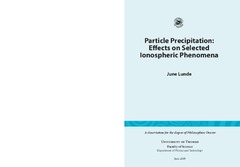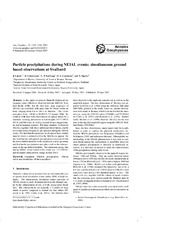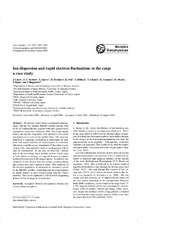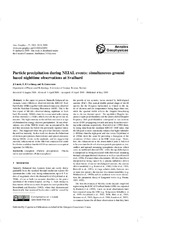| dc.contributor.advisor | Løvhaug, Unni Pia | |
| dc.contributor.advisor | Lorentzen, Dag Arne | |
| dc.contributor.author | Lunde, June | |
| dc.date.accessioned | 2012-06-07T09:02:38Z | |
| dc.date.available | 2012-06-07T09:02:38Z | |
| dc.date.issued | 2009-11-26 | |
| dc.description.abstract | The motivation behind this thesis has been to study particle precipitation from the Sun into the Earth’s upper atmosphere and its effects on selected ionospheric phenomena. Particles from the solar wind can enter the Earth's magnetosphere through magnetic merging, either at the sub-solar point, or at higher latitudes, depending on the configuration of the interplanetary magnetic field. This interaction can be studied from the ground at Svalbard, due to its fortuitous location beneath the magnetospheric cusp region on the dayside, and its location inside the polar cap during night-time. It has been studied how these precipitating particles act on the aurora and ion-acoustic waves in the ionized part of the atmosphere. The studies have been conducted using various methods, including extracting data from databases, running different experiments and building new instrumentation. The latter was a radiation detector for measuring Bremsstrahlung
X-rays. The main instrument used for this study has been the EISCAT (European Incoherent SCATtering) radar located at Svalbard, together with an assortment of other ground based instruments such as photometers, riometers and magnetometers. In addition, particle instruments onboard satellites have been used as well as an X-ray instrument mounted on a balloon launched from Longyearbyen. Primarily, it is the effect of particle precipitation on large ion-acoustic waves that has been studied. These waves can be observed by advanced radar facilities, both from
Svalbard and Tromsø (EISCAT) in the form of spectra known as natural enhanced ion acoustic lines (NEIALs). It has been found that the most energetic particle precipitation causes ion-acoustic waves which mainly propagate downward, while the less energetic part of the particle precipitation is related to ion-acoustic waves which propagate upward. In this project, large ion-acoustic waves have been discovered during night-time at very high latitudes where they were not expected to occur. Previously, these phenomena have only been observed during daytime at Svalbard. Furthermore, in this work, the infrared atomic oxygen emission line (844.6 nm) has been introduced as a new possible method
to detect NEIALs in optical data. Particle precipitation sometimes cause flickering aurora,
hence intensity variation and the apparent motion of flickering spots in the aurora have been studied. Finally, precipitating particles typically consists of electrons and ions, and
in this study, an example is given on of how the merging of the Earth’s and Sun’s magnetic fields guide the precipitation. | en |
| dc.description | Papers 2 and 4 are not available in Munin: <br/>2. T. Grydeland, B. Gustavsson, L. Baddeley, J. Lunde, and E. M. Blixt: 'Conditional integration of Incoherent Scattering in relation to flickering aurora', Journal of Geophysical Research (2008), vol.113, A08305, 8pp. Available at <a href=http://dx.doi.org/doi:10.1029/2008JA013039>http://dx.doi.org/doi:10.1029/2008JA013039</a> <br/>4. B. Gustavsson, J. Lunde, and E. M. Blixt: 'Optical observations of flickering aurora and its spatio-temporal characteristics', Journal of Geophysical Research (2008), vol.113, A12317, 8pp. Available at <a href=http://dx.doi.org/10.1029/2008JA013515>http://dx.doi.org/10.1029/2008JA013515</a> | en |
| dc.identifier.isbn | 978-82-8236-012-8 | |
| dc.identifier.uri | https://hdl.handle.net/10037/4221 | |
| dc.identifier.urn | URN:NBN:no-uit_munin_3936 | |
| dc.language.iso | eng | en |
| dc.publisher | Universitetet i Tromsø | en |
| dc.publisher | University of Tromsø | en |
| dc.rights.accessRights | openAccess | |
| dc.rights.holder | Copyright 2009 The Author(s) | |
| dc.subject | VDP::Mathematics and natural science: 400::Physics: 430::Physics of condensed matter: 436 | en |
| dc.subject | VDP::Matematikk og Naturvitenskap: 400::Fysikk: 430::Kondenserte fasers fysikk: 436 | en |
| dc.subject | VDP::Mathematics and natural science: 400::Physics: 430::Electromagnetism, acoustics, optics: 434 | en |
| dc.subject | VDP::Matematikk og Naturvitenskap: 400::Fysikk: 430::Elektromagnetisme, akustikk, optikk: 434 | en |
| dc.subject | VDP::Mathematics and natural science: 400::Geosciences: 450::Meteorology: 453 | en |
| dc.subject | VDP::Matematikk og Naturvitenskap: 400::Geofag: 450::Meteorologi: 453 | en |
| dc.subject | VDP::Mathematics and natural science: 400::Geosciences: 450::Other geosciences: 469 | en |
| dc.subject | VDP::Matematikk og Naturvitenskap: 400::Geofag: 450::Andre geofag: 469 | en |
| dc.title | Particle precipitation : effects on selected ionospheric phenomena | en |
| dc.type | Doctoral thesis | en |
| dc.type | Doktorgradsavhandling | en |


 English
English norsk
norsk


